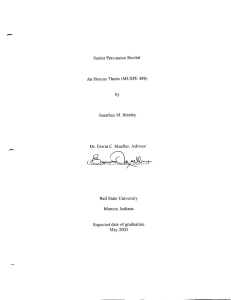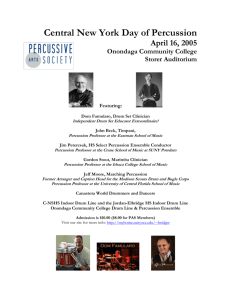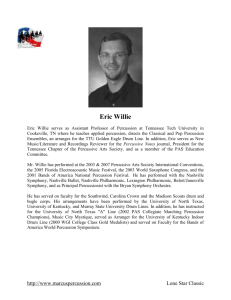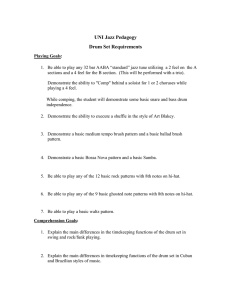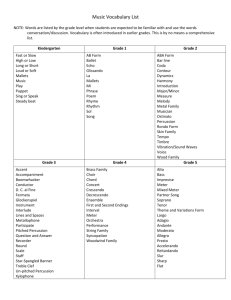EXPANDED PROGRAM NOTES FOR A GRADUATE RECITAL OF LATIN
advertisement
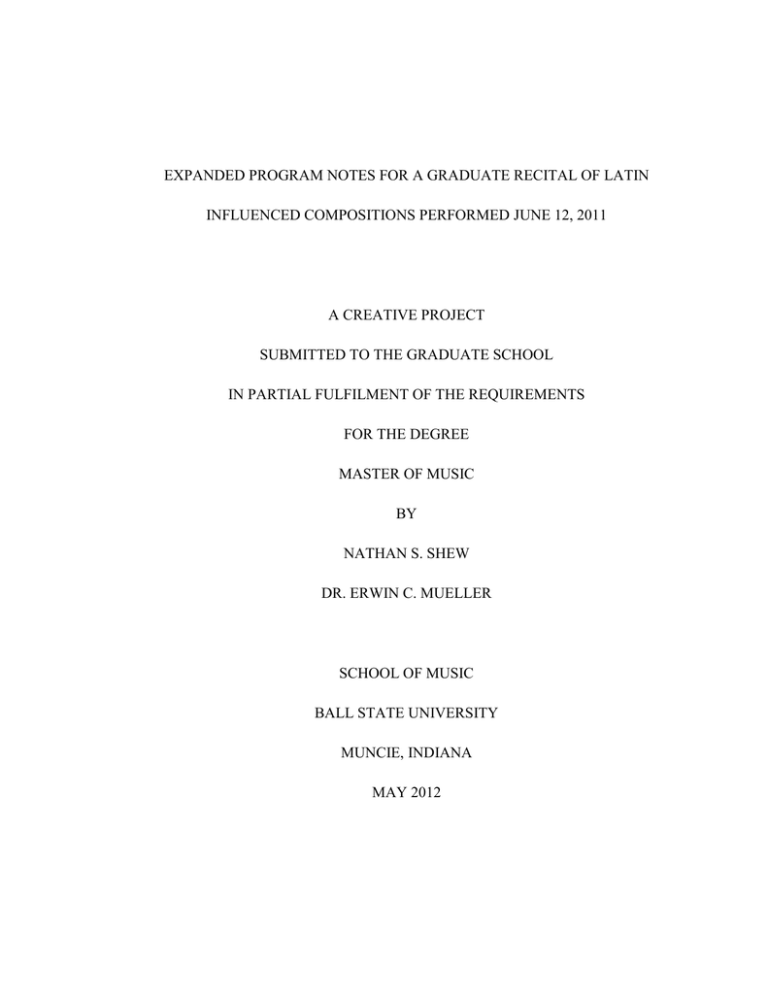
EXPANDED PROGRAM NOTES FOR A GRADUATE RECITAL OF LATIN INFLUENCED COMPOSITIONS PERFORMED JUNE 12, 2011 A CREATIVE PROJECT SUBMITTED TO THE GRADUATE SCHOOL IN PARTIAL FULFILMENT OF THE REQUIREMENTS FOR THE DEGREE MASTER OF MUSIC BY NATHAN S. SHEW DR. ERWIN C. MUELLER SCHOOL OF MUSIC BALL STATE UNIVERSITY MUNCIE, INDIANA MAY 2012 Introduction On June 12, 2011, the writer performed a graduate percussion recital, presented in partial fulfillment of the requirements for the degree of Master of Music in percussion performance. The compositions included in the performance were written within a thirteen-year span, 1992 to 2005, by British, Danish, and American composers. Four of the five compositions are connected through use of Latin American rhythmic and melodic themes. Despite much searching, the fifth piece, for solo snare drum, is the exception as it does not have Latin American themes; however, it does contain short excerpts from Rhapsodie Espanol by Ravel and Capriccio Espanol by Rimsky-Korsakov, both of which exhibit similar ethnic themes. This project will investigate how the composers included Latin American themes into the selected compositions. By understanding the original Latin American themes utilized in these pieces, the performer will be able to adequately convey the intentions of the composer. This research will also show a number of ways that Latin American themes can be incorporated into percussion music. The Excerpt Etude for Snare Drum by Matthew Beck was primarily added to the recital for its use of thirty-one orchestral snare drum excerpts that are found on many audition lists. Not only is the piece technically challenging but also by learning it the performer will perfect these excerpts, which are necessary for a professional percussion career. This project will investigate the ways in which Beck integrated these excerpts into one composition, while maintaining the original tempos of each excerpt through multiple complex metric modulations. 1 James Campbell: Tangents for Timpani and Hi-hat James Campbell, Professor of Music and Director of Percussion Studies at the University of Kentucky, has received worldwide recognition as a performer, teacher, composer, author, and is a respected figure in the development of the contemporary percussion ensemble. He earned a Bachelor of Music degree and Master of Music degree from Northern Illinois University and has toured extensively throughout North, South, and Central America, Europe, and Asia. He is the Principal Percussionist with the Lexington Philharmonic, drummer with the Kentucky Jazz Repertory Orchestra, and Past-President of the Percussive Arts Society. He became well known for his association with the Rosemont Cavaliers Drum and Bugle Corps where he served as their principal instructor, arranger, and program coordinator. He has won multiple awards and has performed at numerous conferences throughout the United States and has composed many pieces for concert and marching percussion.1 Tangents for Timpani and Hi-hat was written for Campbell’s student, John Willmarth, to play on his senior recital. The “tangents” are the five sections through which the piece moves. Campbell labeled these as the opening fanfare, guaguanco, blues, Middle East, and Afro-Caribbean. Each section has a completely different feel and uses the hi-hat in a slightly different way. In that Willmarth was an accomplished drum 1 “Faculty: James B. Campbell,” uky.edu, last modified October 7, 2011, accessed January 20, 2012, http://www.uky.edu/FineArts/Music/faculty/jim_campbell/. 2 set player, the hi-hat was included to allow him to use drum set techniques on an orchestral instrument.2 The piece begins with a short fanfare. Next is the guaguanco tangent that begins with a cascara pattern in the right hand on D. Cascara is the rhythm that is traditionally played on the shell of the timbales in Latin music. After four bars, the hi-hat is added with the 3:2 rumba clave pattern, and the right hand begins to build into a guaguanco pattern. Combining these three patterns produces an unmistakable Latin feel. Both of the four-bar breaks in this pattern are written with the same rhythm and melodic contour as a conga or timbale solo break, further emphasizing the Latin feel of this section. The next section is in a blues style with a slightly slower tempo in 12/8. The beginning of this section is sparse and mainly on the hi-hat giving the performer a brief moment to change the pitches of two drums. The hi-hat plays on twos and fours just as it would for a drum set player performing a blues song. This section features the smear, which is a new technique for timpani. To produce the smear, the player strikes the drum and then places the mallet on the head again and wipes quickly back and forth with lots of force to produce a vibrato. The Middle-East section has numerous meter changes from 7/8, 5/8, 6/8 and 4/8. In the first half of this section the hi-hat is emphasizing the pulse changes throughout each meter by playing on the downbeat. The difficulty in the second half of the section is playing constant quarter notes on the hi-hat through the odd meter changes. The piece ends with an Afro-Caribbean section. The hi-hat here is reminiscent of the triangle pattern in Afro-Caribbean music, alternating between open and closed. The melodic line 2 James Campbell, e-mail message to author, March 6, 2012. 3 on the timpani plays in the rhythm of the 6/8 clave pattern, which emphasizes the difference between the Afro-Caribbean and Guaguanco sections. Through this piece Campbell provides a way for performers to utilize both timpani and drum set skills in a recital setting. With the addition of another sound to the timpani, the hi-hat, Campbell creates not only more technical challenges, but more audience appeal. Astor Piazzolla: Tango Suite: Tango No. 1 and No. 2 Arranged for Marimba Duo by Kevin Super Astor Piazzolla, “King of the Tango,” was a composer and bandleader, as well as a virtuoso performer on piano and bandoneón, a type of accordion that evolved in Argentina. In 1937, he began studying classical music with Ginastera in Argentina while performing and making arrangements for Aníbal Troilo, a famous bandleader. Then in 1944, he left Troilo’s band to form the Orquestra del 46 to perform his own compositions. His Buenos Aires Symphony, written in 1954, earned him a scholarship to study with Nadia Boulanger in Paris. Boulanger encouraged him to continue composing tangos. He created what was called the ‘nuevo tango,’ which incorporated new elements into the tango including fugue, extreme chromaticism, dissonance, elements of jazz, and occasionally expanded instrumentation. The traditionalists of tango in Argentina condemned his music for these changes. However, by the 1980’s, he was widely accepted 4 as the savior of tango.3 Tango Suite No. 1 exemplifies the traits of Piazzolla’s ‘nuevo tango,’ while No. 2 stays truer to the traditional tango. Tango Suite was written for the Assad Brothers Guitar Duo and was originally published in 1985. Dr. Kevin Super, Associate Professor of Music at Liberty University, arranged the piece for two marimbas and bongos. The bongos are played by the first marimbist. The arrangement is almost identical to the original composition except that Super’s arrangement is transposed up a perfect fourth and there are some adjustments due to the capabilities of the instruments.4 The bongo part is added to replace the slaps on the body of the guitar. Tango No. 1 begins with an allegro section with the first player on bongos and the second player on marimba. The main theme is presented in both instruments and has a 33-2 accent pattern that can be found throughout the movement. This movement features chromatic sequencing and dissonance throughout but especially in the last section, rehearsal K. At K the parts are doubled at the octave and incorporate a run of sixteenth notes utilizing ten different pitches at the end of each four-measure phrase. All twelve pitches are used in the sequences of each four-measure phrase. This movement varies from traditional tangos in the use of meter and rhythm, as it switches from 4/4 to 6/8 many times near the beginning and end as if getting stuck on the 3-3 part of the accent pattern. The 6/8 measures are used as a sequencing tool and give the effect of going in a circle by not having the interrupting 2 accent. 3 Cliff Eisen, "Piazzolla, Astor," Grove Music Online, Oxford Music Online, accessed April 1, 2012, http://www.oxfordmusiconline.com/subscriber/article/grove/music/45192. 4 Astor Piazzolla, Tango Suite: para duo de guitarras, transcribed by Kevin Super, (Everett, PA: HoneyRock, 1998). 5 The second movement is closer in style to a traditional tango, but is still very much in Piazzolla’s style. In drastic contrast to the previous movement, this movement is marked as andante, rubato, and melancolico. The main theme is presented in the first marimba at the very beginning as the second marimba adds a counter melody. The theme and counter melody are repeated exactly in the middle, rehearsal C, and at the end, rehearsal F, of the movement. In between these sections are developments on the theme and counter melody. Piazzolla stays closer to traditional tango style by staying in 4/4 and also by using less chromaticism except for a few sequences. Mark Glentworth: Sunbell Mark Glentworth is a percussionist composer and performer. He was one of the youngest students to study percussion at the Royal Northern College of Music at age 16. He works in London as a freelance percussionist for all types of music, including the BBC Symphony Orchestra and the London Sinfonietta. His compositions are quite varied as well from commercial pop to orchestral writing and many things in between. He also composes for stage, TV, and radio programs, and he recently gained more attention for his percussion writing with the completion of his Marimba Concerto No. 1.5 He is best known for Blues for Gilbert, a jazz vibraphone piece that has found its way into the standard percussion repertoire and has been recorded by many percussionists, including Evelyn Glennie, to whom he dedicated Sunbell. 5 “Mark Glentworth: Biography,” markglentworth.com, accessed January 20, 2012, http://markglentworth.com/Site/Biog.html. 6 Sunbell comes from Glentworth’s Vibraphone Suite No. 1, which includes Broken Silence, Ilmo, and Sunbell. Glentworth states in the program notes that each movement can be performed individually as a stand-alone solo or all together as a suite, in which the order is to be chosen by the performer. This movement was the third to be composed. A note is included in the score on the importance of good stick dampening and pedaling. Glentworth notated where he felt stick dampening or pedaling are most important for the clarity of the melodic line and resolution of certain harmonies.6 However he did not notate every instance of stick dampening and pedaling, leaving some of these decisions up to the performer and allowing for individuality and ownership of each performance. The piece begins with a shimmering left-hand roll, a relatively difficult technique, especially at an interval of a third. The right-hand melody in octaves, floats above the shimmer and requires precise mallet dampening to give clarity to the line. Mallet dampening at the octave with one hand is another difficult technique making this opening section the most difficult of the piece even though it sounds simple compared to the quicker Latin section that is to follow. The middle Latin section begins with a syncopated rhythm in the left hand on D4. This rhythm represents the Sunbell, which is repeated, added to, and developed throughout this section. The climax comes exactly two thirds of the way through the piece, a perfect example of the Golden Mean, with a syncopated pattern in the left hand and a simple rhythmically repetitive melody in octaves in the highest register in the right hand. By utilizing tempo, rhythm, dynamics, and pitch at the same time a climax is reached. After a decrescendo from fortissimo to pianissimo, a lone Sunbell enters, this time in the right 6 Mark Glentworth, Sunbell, (Asbury Park, NJ: Keyboard Percussion Publications, 2004). 7 hand on C6. The left hand then has an opportunity to present melodic material before dying away. The slow opening section returns to end the piece, giving a solid sense of returning home with the use of ABA form. Matthew Beck: Excerpt Etude for Snare Drum Matthew Beck currently serves as the Principal Percussionist with the Canton Symphony in Ohio and the West Shore Symphony in Muskegon, Michigan. He received his B.M. from the Cleveland Institute of Music as a student of Richard Weiner and Paul Yancich of the Cleveland Symphony Orchestra, and graduated with a M.M. from DePaul University as a student of Ted Atkatz from the Chicago Symphony Orchestra. Beck has also performed at many music festivals and was previously Instructor of Preparatory Percussion at the Cleveland Institute of Music and a percussion faculty member at the Blue Lake Fine Arts Camp.7 While his is not a household name as a percussion composer, his orchestral experience gives him a strong background for writing this snare drum piece. Excerpt Etude for Snare Drum is a unique solo, which provides a way to practice standard classical snare drum excerpts. Thirty-one different excerpts were pieced together to create this solo, leaving only one note that cannot be attributed to previously composed orchestral literature.8 However, Beck did not just compile excerpts and play 7 “Canton Symphony Orchestra: Matthew Beck,” cantonsymphony.org, accessed January 20, 2012, http://www.cantonsymphony.org/198. 8 Matthew Beck, Excerpt Etude for Snare Drum, (Everett, PA: HoneyRock, 2005). 8 them one after another. He meticulously combined them so that, through juxtaposition and metric modulation, the seemingly dissimilar motives are related. He gives continuity to the piece by emphasizing shared rhythms of different excerpts and by repeating parts of single excerpts. The easiest excerpt to recognize is the frequently heard rhythm from Ravel’s Bolero. Each return of its simple repetitive pattern creates more unity and reminds the listener this is one piece and no longer separate parts. When asked what motivated him to write this piece Beck responded with this: I was getting bored practicing the same excerpts over and over for audition after audition, and I was looking for a way to improve pulse over large beats. I found that by having a base tempo of mm=31, I could largely play any excerpt at that tempo by just varying how that pulse was subdivided. For example: Lt. Kije is whole note = 31, mvt. 3 Sheherazade is dotted half = 31, mvt. 4 Sheherazade is three bars = 31, etc. The tempos are not perfect for every excerpt but they are pretty close.9 This etude provides many things to perfect for percussionists, not only the excerpts, but also the technical skills, rapidly changing dynamics, constantly changing rhythmic subdivisions, and endurance. To properly play this piece, the performer should study each excerpt individually and play it in the character of its original setting. This will take considerable time but the end result will be not only knowing and understanding each excerpt individually but also being able to use them properly in one coherent piece that provides an excellent demonstration of his skills. 9 Matthew Beck, e-mail message to author, March 6, 2012. 9 Kai Stensgaard: Concierto Mexicano Kai Stensgaard is a Danish performer, composer, and entrepreneur who has been gaining popularity recently with his six-mallet marimba technique and the conception and production of the Aluphone, a brand new percussion instrument that is a cross between the vibraphone and crotales that is made out of tuned aluminum fence post caps. Stensgaard has studied percussion in Denmark and California State University. He has studied marimba performance with Leigh Howard Stevens and has performed as a soloist, with an ensemble and given master classes throughout the world, including Mexico, Guatemala, Argentina, Bali, Spain, and the United States.10 Stensgaard’s marimba compositions give a glimpse of his greatly varied studies. Most of the compositions are based on some sort of Latin style: Mexican, Mayan, Guatemalan, Spanish, Caribbean, or Argentinean. However, he does have one piece based on a Danish folk song and one representing an African marketplace. His compositions include marimba solos, duos, trios, a quartet, and duos for marimba or vibraphone and saxophone. He gave the world premiere concert of Concierto Mexicano in 2006 in the United States. In his program notes for this selection, Stensgaard says that he got the idea to write it from his love of the Latin salsa dance and the spicy Mexican salsa sauce that was introduced to him by his Mexican friends, members of Marimba Nandayapa. Many of the melodies of the concerto are ones that Stensgaard has used in his other marimba 10 “Kai Stensgaard – Marimba,” eng.marimba.dk, accessed January 20, 2012, http://eng.marimba.dk/reference.html. 10 compositions. The beginning of the first movement quotes Rain Forest for saxophone and marimba. The whole movement builds to a climax in the ending section with a Mexican Zapateado traditional song, Aunque me lleve el Diabolo. Although this tune is originally in 6/8, Stensgaard puts it in a quick 4/4. The second movement was inspired by Stensgaard’s first trip to Guatemala, “la tierra de la marimba.” The theme is a typical Guatemalan dance that has Spanish influences and begins in a slow expressive waltz for the solo marimba before speeding into the traditional Guatemalan dance rhythm. This theme is also found in Manzanila from Two Mayan Dances, one of Stensgaard’s first pieces for six mallets. The third and final movement begins with the salsa rhythm at half tempo and in this context does not sound like a salsa. However, at rehearsal F the marimba plays the true salsa rhythm with six mallets. At rehearsal K, the waltz melody from the second movement returns. Here the orchestra returns to the salsa rhythm in 4/4 while the marimba continues the waltz, giving the effect of hearing more than one group playing at the same time in a town square.11 This concerto requires great technical abilities and stamina from the soloist. There are sections for two, four and six mallets requiring the mastery of different techniques. The concerto can be performed with orchestra, wind band, piano, or a CD accompaniment of the orchestra. This allows the piece to be very versatile. Stensgaard captures the character of Mexican music through the use of the orchestra; specifically the trumpets that are orchestrated to sound like a mariachi band. 11 Kai Stensgaard, Concierto Mexicano, (Denmark: Stensgaard, 2004). 11 Conclusion The works presented in this recital consist of advanced repertoire for the four main instruments of percussion performance, each of which uses elements of Latin music: the timpani piece through direct use of Latin rhythms; the marimba duet through transcription of the Argentinean tango; the vibraphone through program title and suggestive rhythms; the snare drum through quotation of Spanish based pieces; and the marimba concerto through direct use of traditional Mexican and Guatemalan folk melodies and salsa rhythms. Each selection is very challenging, not only technically, but also in creating the proper feel and style for each example of Latin music. It is hoped that percussionists will benefit from the information in these expanded program notes and be inspired to perform the compositions that are not well known but more than worthy of adding to a repertoire list. 12 13 Bibliography Beck, Matthew. Excerpt Etude for Snare Drum. Everett, PA: HoneyRock, 2005. “Faculty: James B. Campbell.” uky.edu. Last modified October 7, 2011. Accessed January 20, 2012. http://www.uky.edu/FineArts/Music/faculty/jim_campbell/. Campbell, James. Tangents for Timpani and Hi-hat. Nashville, TN: Innovative Percussion, 1997. “Canton Symphony Orchestra: Matthew Beck.” cantonsymphony.org. Accessed January 20, 2012. http://www.cantonsymphony.org/198. Glentworth, Mark. Sunbell. Asbury Park, NJ: Keyboard Percussion Publications, 2004. “Kai Stensgaard - Marimba.” eng.marimba.dk. Accessed January 20, 2012. http://eng.marimba.dk/Welcome.html. “Music and Humanities: Dr. Kevin Super.” liberty.edu. Accessed March 6, 2012. http://www.liberty.edu/academics/arts-sciences/musicandhumanities/index. “Mark Glentworth: Biography.” markglentworth.com. Accessed January 20, 2012. http://markglentworth.com/Site/Biog.html. Piazzolla, Astor. Tango Suite: para duo de guitarras. Transcribed by Kevin Super. Everett, PA: HoneyRock, 1998. Stensgaard, Kai. Concierto Mexicano. Denmark: Stensgaard, 2004. Cliff Eisen. "Piazzolla, Astor." Grove Music Online. Oxford Music Online. Accessed April 1, 2012. http://www.oxfordmusiconline.com/subscriber/article/grove/music/45192. 14
